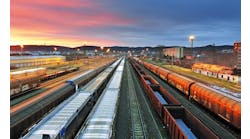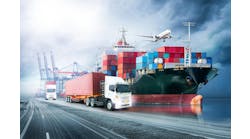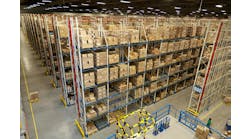With the large number of assets needed by the world's major expedited and express delivery providers to best serve their customers, it's small wonder they all are taking responsible measures to reduce energy use. Results are reduced expenses as well as helping to clean the air in their parts of the globe.
Lighting up has made it easier to be green for these companies. One step among many UPS, FedEx and DHL have undertaken is to deploy solar technology on the roofs of their facilities around the world.
At its 23,000 sq ft Palm Springs, CA, sorting facility, UPS employs a 104.5 KW solar panel array system to produce 70% of all electricity the building requires. Shell Solar installed the system on the rooftop. The array consists of three rows of 145 panels, a total of 864 individual modules.
Sorting operations at the facility occur in the late evening or early morning, when the sun isn't shining. As a result, solar energy generated by the array isn't used directly during sorting. Instead, solar energy generated during daylight hours is sent to the California power grid. As energy is required during hours of darkness, energy from the grid is used. This type of exchange is called “net metering.” UPS claims that it achieves almost zero kilowatt per hour of annual consumption.
UPS explains that in addition to gaining insight and experience with the use of solar technology, the array has exceeded expectations in producing 4.9% more power than was expected. Further, since its deployment, the company has reduced CO2 emissions by 1 million pounds since its installation in 2003.
Further north in California, in 2005 FedEx Express activated a solar array at its West Coast Hub at Oakland. It included 300,000 Sharp solar cells incorporated into 5,769 photovoltaic modules. The 904 KW system is able to meet 80% of the facility's peak energy demand. In all, the 5,700 solar electric panels that comprise the system cover some 81,000 sq ft. An additional benefit is that the panels provide some additional insulation, helping to reduce heating and cooling costs.
FedEx claims that 3 million KW hours of renewable energy have been generated by the system through its three years of operation with avoidance of 1,000 tons of CO2 being released into the atmosphere. The company has created additional solar systems, from BP Solar, at its California facilities in Whittier and Fontana.
FedEx Express has broken ground on creation of a new Central and Eastern European hub at the Cologne/Bonn, German airport. Planned to be completed in 2010, the new facility will have a 1.4 megawatt solar power system that will generate 1.3 gigawatt hours of electricity a year. Solar panels will cover the roof of new ramp and sort facilities, a total surface area of 16,000 sq meters.
Mitch Jackson, the company's director of environmental affairs and sustainability, observes, “On-site renewable energy generation has been extremely efficient and successful for FedEx, and we are continuously looking for new investments. The solar energy installation at the Cologne hub will nearly double FedEx's use of on-site solar energy.”
Further east in Germany DHL opened its new European air freight hub at the Leipzig/Halle airport in late May. In creating the facility, the carrier gave special attention to environmental protection, one aspect of which is a photovoltaic unit containing 1,000 square meters of solar cells on the roof of the workshop. DHL expects to receive 100,000KW of electricity per year from the array. Further it expects to save 3,000 tons of CO2 emissions each year by combining savings from its unique heat and power plant with the photovoltaic system.
The hub is the first DHL facility to meet its requirements for electricity, heating and cooling in a greatly self-sufficient manner. The facility uses a cogeneration unit for heat and power generation. The gas-fired power plant produces energy to heat buildings in the winter and cool warehouses in the summer.
Rainwater is collected in two cisterns at the hub. The 3,000 cubic meters of water are then used for such things as cleaning of aircraft and for industrial water supply. This reuse takes the place of what would be drinking water for the same purposes.
With the understanding that the world's transport sector generates about 14% of global CO2 emissions, Dr. Frank Appel, Chairman of the board of Deutsche Post WorldNet, owner of DHL, says, “We realize we have a responsibility for environmental protection. There is no denying that climate warming is coming. But we have the ability to control the degree of change. For this reason, we launched a global environmental protection program called GoGreen in which we voluntarily focus our actions on standards laid down by the Kyoto Protocol. Specifically, this means one thing: We intend to cut carbon-dioxide emissions for every mailed letter, every transported container and every used square meter of space by 30% by the year of 2020.”
DHL is not alone in its efforts to improve the environment through its efforts and the use of solar energy is not the only tool being used by the express community.
FedEx has developed a customized lighting solution it has installed at its facilities, offices and retail locations. The result has been a 93% reduction in energy consumption. In its Geneva, Switzerland station, FedEx has a geothermal system that utilizes a system of pipes running deep underground that warm the building in winter and cool it in the summer.
The carrier has integrated cleaner vehicles into its fleet around the world to help reduce emissions. It points to several locations that serve as examples of its overall commitment to improving environmental conditions. In Japan it is collaborating with General Motors to test operations of a fuel-cell delivery truck. In London FedEx is using liquefied petroleum gas in 39 Mercedes-Benz sprinter vans that have reduced carbon emissions by 12%. Vehicles in FedEx fleets in Vicenza and Milan, Italy, operate on compressed natural gas.
UPS has become the first shipping company to join the US Environmental Protection Agency's (EPA) Climate Leaders program. As UPS explains, this is an industry-government partnership in which participating companies commit to undertake corporate-wide inventory of greenhouse gas emission, set aggressive goals for reducing them and annually reporting progress to EPA.
Scott Davis, UPS chairman and CEO, explains, “Our decision to join the Climate Leaders program is just the latest demonstration of a long commitment by UPS to operating in an environmentally responsible way. UPS has been investing in more efficient technologies for more than 80 years and already leads the industry in fuel and energy conservation.”
Davis notes several of the company's most recent accomplishments in helping to reduce its environmental impact. UPS claims it operates the industry's largest private fleet of alternative fuel vehicles. This year it has added to its fleet with the purchase of 500 hybrid electric and compressed natural gas vehicles.
Administrative changes have resulted in savings for UPS, as well. It saved 3 million gallons of fuel last year through optimization of delivery routes in order to minimize left-hand turns. Its airlines reduce the number of engines used in taxiing in order to save on fuel. They are now using a new flight planning system to calculate the most efficient routes based on weather, terrain, winds and other factors.
Along with many others in transportation, these companies are taking very seriously their membership in the world community. Their efforts are not only contributing to a cleaner environment, they are finding positive reinforcement on many levels, not the least of which is increasing the bottom line.


